Abstract
The Arctic system has experienced in recent times an extreme reduction in the extent of its sea ice. The years 2007 and 2012 in particular showed maxima in the loss of sea ice. It has been suggested that such a rapid decrease has important implications for climate not only over the system itself but also globally. Understanding the causes of this sea ice loss is key to analysing how future changes related to climate change can affect the Arctic system. For this purpose, we applied the Lagrangian FLEXible PARTicle dispersion (FLEXPART) model to study the anomalous transport of moisture for 2006/2007 and 2011/2012 in order to assess the implications for the sea ice. We used the model results to analyse the variation in the sources of moisture for the system (backward analysis), as well as how the moisture supply from these sources differs (forward analysis) during these years. The results indicate an anomalous transport of moisture for both years. However, the pattern differs between events, and the anomalous moisture supply varies both in intensity and spatial distribution for all sources.
1. Introduction
The Arctic system has been experiencing strong reductions in sea ice over the past few decades [1,2,3,4], and the decrease is expected to continue under global warming [5,6]. The observed decreases have affected not only the extent but also the thickness and the volume of the ice [7]. For the period 1979–2010, the annual mean extent of sea ice showed a decrease of more than 4% per decade [8]. While a decreasing trend for the total extent of Arctic sea ice is apparent for all months [8,9], the trend is greatest in summer [1,10], when the sea ice extent is at its lowest annual value [11,12,13,14]. The month showing the minimum sea ice is September, with a downward trend of more than 12% per decade for the period 1979–2010 [1,10]. Reductions in sea ice have important implications locally, affecting heat budgets [15] and precipitation [16], but the effects are also external and global. Some authors suggest that sea ice reductions have implications for atmospheric circulation by affecting mid-latitudinal winter snowfall [17] or summer precipitation [18]. A detailed review of sea ice reductions and their effects is available in Vihma [19].
The years 2007 and 2012 had the minima September sea ice extent over recent decades, with anomalies of −1.6 and −2.3 million km2 respectively compared with the 1981–2010 climatological mean [19]. The sea ice data from the National Snow and Ice Data Center (NSIDC) [20] shown in Figure 1 reveal the reduction in September sea ice extent in 2007 (green) and 2012 (dark blue) compared to the 1981–2010 mean (red line). Major reductions have been seen north of the Bering Strait, over the Laptev, East Siberian, Chukchi and Beaufort Seas. Especially remarkable are the reductions north of Eurasia in 2007 and north of Alaska in 2012. Some reductions also appear over the Barents and Kara Seas and over the Canadian Arctic Archipelago, especially in 2012. A number of studies have recently been undertaken to assess the possible causes of the sea ice reduction. These causes were summarised by Meier et al. [9], Stroeve et al. [14], and Polyakov et al. [21]. The recent change in the perennial sea ice [22,23] is considered one of the most important reasons for the decrease in sea ice volume by several authors. However, variations in the hydrological cycle can affect sea ice too, and in some reports the reduction in sea ice has been related to increased river discharge [24,25,26] or storm activity [27,28].
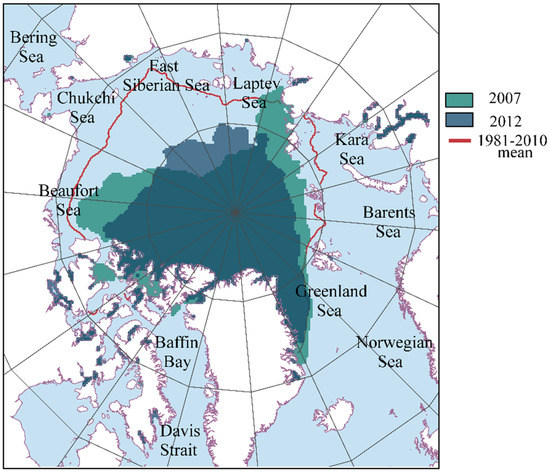
Figure 1.
September minimum sea ice extent for the years 2007 (green) and 2012 (dark blue), with climatological 1981–2010 mean (red contour). Data obtained from National Snow and Ice Data Center (NSIDC).
Atmospheric moisture transport has an important role in sea ice extent variations. The increase in cloud cover or water vapour over the Arctic have been suggested as one of the main causes of the downwelling longwave flux [29,30], which is considered to be closely related with sea ice extent [29,31]. The relation between the amplified moisture transport toward norther latitudes and its influence on river discharge was demonstrated by Zhang et al. [32]. Several authors have discussed the recent increase in river discharge over the Arctic (e.g., [33,34]), and it was determined that the river discharge has an influence over the Arctic system in different ways [24]. Although its influence on sea ice extent remains unclear, several studies have suggested a link between river runoff and summer ice melt or early freezing [25,26,35].
Moisture transport is a key component of the hydrological cycle and its study could be helpful in the analysis of changes observed in the climate system [36]. In the present study, we analyse anomalous moisture transport into the Arctic system for the years of observed minimum sea ice extent: 2007 and 2012. For this purpose, we employed the Lagrangian FLEXible PARTicle dispersion (FLEXPART) model [37,38] to assess variations in arctic moisture sources, and to observe how the moisture contribution from these sources into the Arctic varied for 2007 and 2012, as a means of investigating the possible relationship between variations in moisture supply over the main arctic river basins and any reductions in sea ice. Lagrangian techniques have been widely applied for evaluating moisture transport (e.g., [39,40]). The main advantages and disadvantages of this methodology were addressed by Gimeno et al. [41], and an intercomparision was made between the different methodologies applied with this purpose.
2. Experiments
In order to analyse anomalous moisture transport into the Arctic linked to sea ice retreat, a Lagrangian methodology based on the FLEXPART v9.0 particle dispersion model [37,38] was applied. The Arctic domain used for this work was defined by Roberts et al. [42] as “the geosphere and biosphere north of the boreal mean decadal 10 °C sea surface isotherm, the surface air 0 °C contour that encircles the North Pole, and the southern limit of terrain that drains into the High Arctic”. This appears in Figure 2 in the light and dark blue, red and dark pink filled regions. The FLEXPART model employs the global reanalysis data from ERA-Interim with a 1° regular grid and 61 vertical levels, obtained from the European Centre for Medium-Range Weather Forecast (ECMWF) [43], and tracks atmospheric moisture along trajectories. The 3-D wind field is used to move many (near 2 million) so-called particles (air parcels) that result from the homogeneous division of the atmosphere. For each air parcel, the specific humidity (q) and position (latitude, longitude, and altitude) are stored at 6-h intervals.
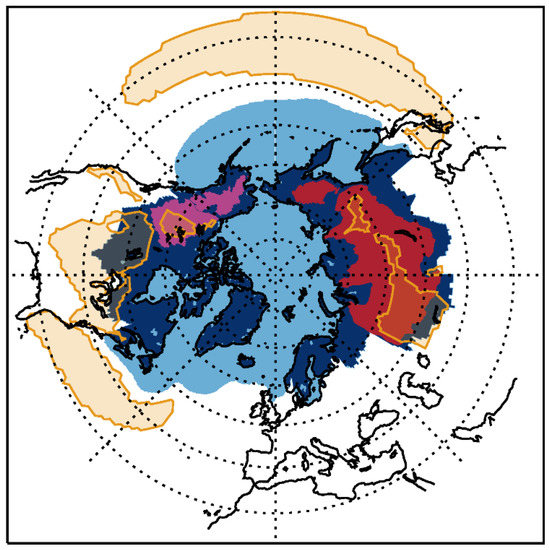
Figure 2.
Main regions of study. The total solid colour-filled area (dark and light blue, red and pink) represents the Arctic domain as defined by Roberts et al. [42]. The red and pink regions represent the Eurasian and Canadian river basins respectively as considered in this study. Yellow contour areas represent the sources of moisture for the Arctic system used in the forward experiment developed by Vázquez et al. [47] in annual climatology from 1980–2012.
Changes in the specific humidity of the particle are related to increases (e) and decreases in moisture (p) by the equation:
where m is the mass of the particle and t is the time. The total surface freshwater flux (E–P) is obtained at each grid position by adding (e–p) from all the air parcels observed over it. (E) and (P) are the rates of evaporation and precipitation per unit area, respectively.
e–p = m(dq/dt),
The trajectory of the particles can be followed both backwards in time with the aim of identifying sources of moisture for a specific area, and forwards in time to analyse the sinks of the moisture transported from a given source (e.g., Gimeno et al. [40,44] for backward analysis, and Gimeno et al. [45] for forward analysis). Both approaches were used in the present study. First, the trajectories for particles reaching the Arctic system every day were obtained by backward tracking for the whole year prior to the 2007 and 2012 minimum sea ice extents. Particles were tracked for a period of 10 days as it represents the average time of residence of water vapour in the atmosphere [46]. From this analysis, we were able to analyse where particles gained (and lost) moisture on their trajectories towards the Arctic. By considering at each grid point the total freshwater flux resulting from all particles tracked backwards from it, we obtained the sources of moisture for the Arctic for those areas where evaporation exceeded precipitation (E–P) > 0. In addition to the years 2007 and 2012, the sources for the period 1980–2012 were used to provide the climatological mean in order to allow comparisons to be made. Climatological sources as used in this study were previously calculated by Vázquez et al. [47], in which sources were defined as those areas where (E–P) exceeded 4 mm/day for the backward experiment; they are represented by the yellow contours in Figure 2. Only the Pacific and Atlantic Ocean, North America, and Siberia were considered in the analysis to represent those continental and oceanic sources with major seasonal importance [47]. Secondly, in addition to backward tracking, trajectories were tracked forwards in time from the climatological Arctic sources (yellow contours in Figure 2) in order to analyse the variation in moisture supply into the Arctic. An area is considered to be a moisture receptor from a source when, taking the contributions of all the particles crossing the region, it is revealed that precipitation exceeds evaporation (E–P) < 0.
The analysis for both the sources and their contribution to the Arctic, for years showing minimum sea ice extents (2007 and 2012), was achieved by calculating anomalous (E–P) with reference to the climatology for 1980–2012. For the backward analysis only the (E–P) > 0 values were considered, and for the forward analysis we considered only those areas where (E–P) < 0.
To assess the possible implications for sea ice extent as affected by river discharge, in addition to the total system, the moisture contribution from the main Arctic river basins was also investigated. We consider the Eurasian and Canadian basins separately because of their influence over the different regions of the Arctic Ocean. The Eurasian river basins considered herein are Lena, Ob, Yenisey and Kolyma (the red-coloured areas in Figure 2); the main Canadian basins are McKenzie and Yukon (pink areas in Figure 2). For both areas, we calculated the mean moisture supply for each period of interest (2007, 2012) and climatology separately, which we then integrated over the basin areas.
The analysis described above was applied on both a seasonal and an annual basis. Because the minimum sea ice extent occurs in September, we considered the period from September to August 2006–2007 and the same period in 2011–2012. Hereinafter these periods are denoted 2006/2007 and 2011/2012. Seasons were defined as autumn (September to November; SON), winter (December to February; DJF), spring (March to May; MAM), and summer (June to August; JJA).
3. Results
3.1. Changes in Moisture Sources
Figure 3 shows the seasonal anomalies for 2006/2007 and 2011/2012 in moisture uptake (E–P) > 0 for backward analysis from the Arctic system. Positive anomalies (reddish colours) represent those areas where the particles took more moisture during these years on their transport to the Arctic compared to climatological mean. The opposite is valid for negative anomalies (bluish colours). Contour magenta lines represent the climatological seasonal moisture sources as defined previously [47]. From this figure, we observed variations in the moisture sources for those years with minimum sea ice extent. To facilitate the interpretation of this figure, Figure 4 shows (E–P) climatological seasonal values for both years. Climatological sources for the period 1980–2012 can be found in Vázquez et al. [47].
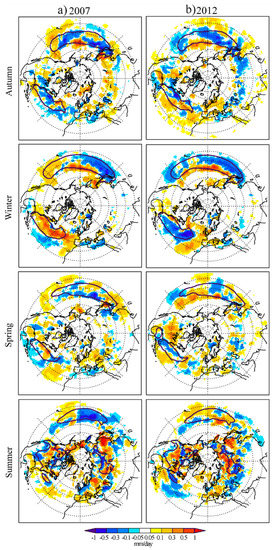
Figure 3.
Seasonal evaporation–precipitation (E–P) > 0 anomalies for (a) 2006/2007 and (b) 2011/2012 compared with the 1980–2012 climatology. The reddish colours represent areas over which moisture uptake is greater that year (positive anomalies) and the bluish colours represent areas where moisture uptake is lower that year (negative anomalies). Contour magenta lines represent the main climatological moisture sources for the Arctic system based on the results of Vázquez et al. [47].
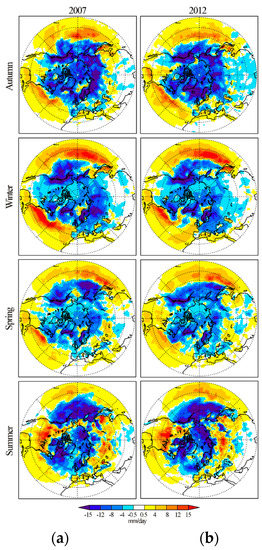
Figure 4.
Climatological seasonal 10-day integrated (E–P) values observed for the period 2006/2007 (a) and for the period 2011/2012 (b), for all the particles bound for the Arctic domain, determined from backward tracking. Red colours represent moisture sources and blue colours represent moisture sinks.
As found by Vazquez et al. [47], Atlantic and Pacific Oceans represent main moisture sources for the Arctic Ocean for the entire year, and North America and Siberia become relevant sources only in summer. In general, it can be seen from Figure 3 that the Atlantic source increases its moisture uptake over the climatological source area for 2006/2007, with the exception of autumn. Meanwhile for 2011/2012, in general the moisture uptake from Atlantic Ocean shows an increase around climatological area and a decrease over the climatological source itself. For the Pacific source, major differences between both years appear in spring and especially in summer; for these seasons, moisture uptake shows an increase for 2012, which does not appear in 2007. Finally, relating to continental summer sources, both years show a general increase in moisture uptake from North America. From the Siberian source, it seems to be displaced northward for 2012, however only the south part of the source shows positive anomalies in 2007.
For 2006/2007 (Figure 3a), and considering autumn, it appears that the uptake of moisture from the Atlantic source was reduced. For the Pacific Ocean in general, the moisture uptake became weaker over the climatological source area (contoured area); however, evaporation increased over some areas around this region. Especially remarkable is the increase in E–P that occurred over the eastern Pacific. In Figure 4a it can be seen that this source appears separated into two different areas. Despite not being the main source, in autumn the Norwegian and Barents Seas showed an increase in their potential moisture contribution to the system, and some Eurasian continental areas gained in importance as well. In winter the Atlantic moisture source clearly increased its moisture uptake and expanded eastwards (see also Figure 4a). Meanwhile, the Pacific Ocean seems to have gained in importance as a source northwards and eastwards and have decreased its moisture uptake in a southwest direction. In this season, an important increase in moisture uptake is also observed over the Okhotsk Sea (to the north of Japan and delimited to the east by the Kamchatka Peninsula). In spring, the Atlantic source seems to have a reduced eastward extent compared with the climatological source and an intensification can be seen over its central area. A slight increase in moisture uptake can be observed over the eastern Atlantic Ocean. The Pacific source shows an uneven pattern, with negative anomalies over most of the source and positive ones over the southeastern climatological source area and over Japan and the East China Sea. Positive anomalies higher than 0.3 mm/day can be seen over the Bering Sea and Europe. Finally, in summer the North American source increased its moisture uptake over most of its area. Over Eurasia, positive anomalies generally appear around the latitudinal 50° N band, and China gains importance as a source with greater (E–P) values than Siberia (Figure 4a). For the Atlantic Ocean, moisture uptake increased over most of the area despite the fact that this source is not that important in this season. The Pacific source showed negative anomalies over most of its area, indeed this source was somewhat limited to the eastern Pacific this year, as shown in Figure 4a.
For 2011/2012 (Figure 3b), in autumn the moisture uptake over the Pacific moisture source was considerably reduced. The Atlantic moisture source seems to be displaced southwards and, in general, evaporation increased over the ocean below 40° N and the Gulf of Mexico. The positive anomalies seen over Europe for this season are also remarkable. In winter, the Atlantic source weakened over the climatological source area and the ocean to the north and east. In Figure 4b, it can be seen that two different evaporative areas appear over the Atlantic Ocean. The first coincides approximately with the climatological source and the second is located over the eastern Atlantic. The Pacific Ocean showed negative anomalies over most of its area, with the exception of a band of positive anomalies between 30° and 40° N. Positive anomalies appeared too over the Okhotsk Sea and the western Bering Sea. In spring, over the Atlantic climatological source area the moisture uptake was considerably lower, with slight increases observed mainly to the south of the climatological source. Over the Pacific Ocean, positive anomalies are seen to the northeast of the source, suggesting an expansion of the moisture source in this direction. It is important to highlight the positive anomalies over the North American source, suggesting an earlier development of this source, which usually only appears in summer. Finally, in summer the Atlantic Ocean generally shows negative anomalies over most of the western Atlantic Ocean. However, positive anomalies also appear to the east of Florida suggesting a southward displacement of the source, which can be observed in Figure 4b. The Pacific Ocean mainly shows an increase in moisture uptake. For the continental moisture sources, North America seems to have a higher moisture uptake over most of its area. Moreover, Alaska gained in importance as a source for this season. The Siberian source was displaced northwards (see Figure 4b), showing very strong positive anomalies to the north of the source. China and Europe also show a higher moisture uptake.
All the available data are brought together in Figure 5, which shows the total seasonal moisture uptake (E–P) > 0 for each source for both years (2006/2007 and 2011/2012) and for the climatology mean (1980–2012). Following the same methodology as that employed by Vázquez et al. [47], sources for 2006/2007 and 2011/2012 were defined as those areas showing values greater than 4 mm/day over the Pacific and Atlantic Ocean, North America, and Siberia (see Figure 4). For each of the four sources, the total (E–P) value was calculated. An increase in moisture uptake may be seen for almost every source and season. The only exception is over the Pacific area, which shows decreases in moisture uptake in winter, and especially in autumn of 2006/2007 and during summer of 2011/2012. Especially relevant also are the increase in spring and summer for 2011/2012 over this source. Over the Atlantic area, some reduction appeared for autumn 2006/2007, and there was a notable increase in moisture uptake occurring in winter for this year. In 2011/2012 the total (E–P) increased for every season, with higher values appearing in autumn and a negligible increase in summer. As for the continental sources in summer, these intensified in moisture uptake in both years. However, the total (E–P) was greater for 2011/2012, which could justify the increased sea ice retreat in 2012 compared to 2007.
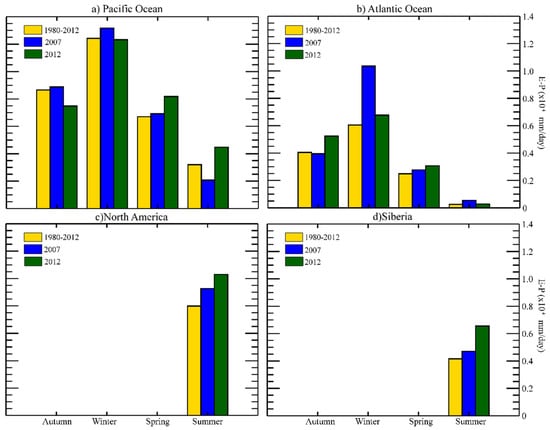
Figure 5.
Total seasonal moisture uptake (E–P) > 0 for 1980–2012 (yellow bar), 2006/2007 (blue bar) and 2011/2012 (green bar) over each source of moisture: (a) Pacific Ocean; (b) Atlantic Ocean; (c) North America and (d) Siberia.
3.2. Anomalous Moisture Contribution from Each Moisture Source
The forward analysis allows us to analyse anomalous transport of moisture from the main climatological moisture sources (yellow contour lines in Figure 2) into the Arctic system for those years showing minimum sea ice extent. To analyse the geographical variations in moisture transport, Figure 6 and Figure 7 show the seasonal moisture contribution anomalies for each of the main sources for 2006/2007 and 2011/2012, respectively. In order to link moisture transport and sea ice retreat, the purple contour indicates the sea ice extent at the end of every season.
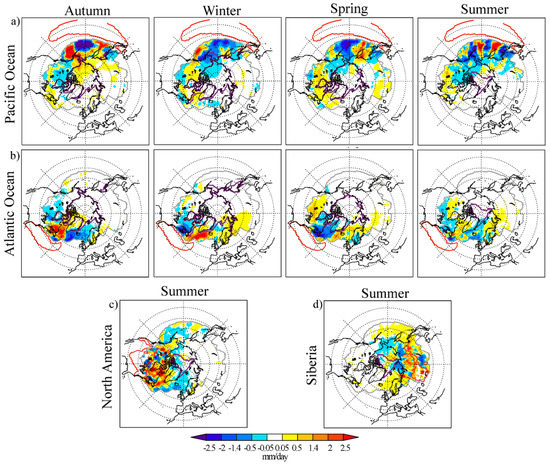
Figure 6.
Seasonal (E–P) < 0 anomalies for 2006/2007 in the forward experiment from (a) the Pacific Ocean (b) the Atlantic Ocean (c) North America and (d) Siberia. Reddish colours represent areas over which the moisture supply is greater that year from the selected source (positive anomalies) and bluish colours represent areas where the moisture uptake is lower that year (negative anomalies). Red contour lines represent climatological moisture sources for the Arctic system. Purple contour lines represent the sea ice extent at the end of every season.
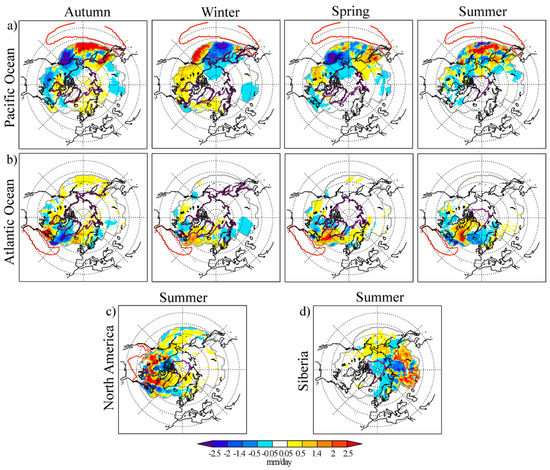
Figure 7.
Seasonal (E–P) < 0 anomalies for 2011/2012 in the forward experiment from (a) the Pacific Ocean (b) the Atlantic Ocean (c) North America and (d) Siberia. Reddish colours represent areas over which the moisture supply is greater in that year from the selected source (positive anomalies) and bluish colours represent areas where the moisture uptake is lower (negative anomalies). Red contour lines represent climatological moisture sources for the Arctic system. Purple contour lines represent the sea ice extent at the end of every season.
For the Pacific moisture source (Figure 6a) we observed important differences in the (E–P) < 0 anomaly by season. Focusing the analysis on those areas showing major sea ice retreat, for this moisture source we observed an important increased moisture contribution north of the Bering Strait in autumn, affecting the area where the maximum September ice retreat was observed (see Figure 1). In spring and summer, some increases are observed north of Siberia, where sea ice loss is especially important. Figure 6b shows the (E–P) < 0 anomaly for the Atlantic moisture source. An amplification of the moisture contribution from the Atlantic moisture source can be observed to the northeast of the source for winter, spring, and summer affecting the Barents and Kara Seas, where sea ice retreat was observed over this period. In autumn, however, there was no important increase in moisture contribution over this area, in fact the transport from the Atlantic source was amplified mainly to the west of Greenland. This region is also affected by an amplified moisture transport from the North American source in summer (Figure 6c). Increased moisture contribution from both sources could have affected the sea ice retreat over the Canadian Arctic archipelago observed in 2006/2007. The contribution of the Siberian moisture source (Figure 6d) showed a strong increase to the north of the source, with an amplified contribution over the Pacific Ocean, Scandinavia, and the Atlantic Ocean. Increased moisture contribution appeared over the Arctic Ocean between the Laptev Sea and the East Siberian Sea.
As far as the geographical variations in moisture supply for 2011/2012 are concerned (Figure 7), for the Pacific source (Figure 7a) negative anomalies in moisture contribution (E–P) < 0 are generally seen over the East Siberian, Chukchi, and Beaufort Seas between autumn and spring. Positive anomalies, however, are observed over the East Siberian Sea in summer. This area suffered an unusual sea ice retreat during this season (see also Figure 1). For 2011/2012 the Pacific source seems to show an increased moisture contribution over the Barents and Kara seas in autumn, and the Norwegian Sea in autumn and winter. For the Atlantic Ocean (Figure 7b), as in 2006/2007, the moisture contribution increased northeast of the source. In this case, the increase occurred in autumn, winter, and spring, affecting the Barents and Kara Seas. In summer, however positive anomalies over these seas can be only observed from North American source, In this season, some increases in moisture transport can be observed over the Canadian Arctic archipelago, from both the Atlantic and North American (Figure 7c) sources. The variation in moisture supply over this area is negligible for the remaining sources and seasons. Finally, for the Siberian moisture source (Figure 7d) the anomalies in moisture contribution over the Arctic Ocean are mainly negative. Positive anomalies can be seen over the East Siberian and Chucki Seas and over the Kara Sea.
With the aim of analysing the net variation in (E–P) over the system as a whole, Figure 8 shows the total seasonal moisture contribution from each moisture source, computed by integrating (E–P) for each grid cell and considering only values where (E–P) < 0. For the year 2006/2007, for the Pacific source the moisture contribution was generally lower compared with the mean contribution for 1980–2012. The only exception occurred in the autumn when the moisture contribution showed a slight increase. The Atlantic moisture contribution increased in autumn and winter; meanwhile, it showed similar values to the climatology for spring and summer. Finally, from both the continental sources, North America and Siberia, moisture transport over the Arctic was considerably greater.
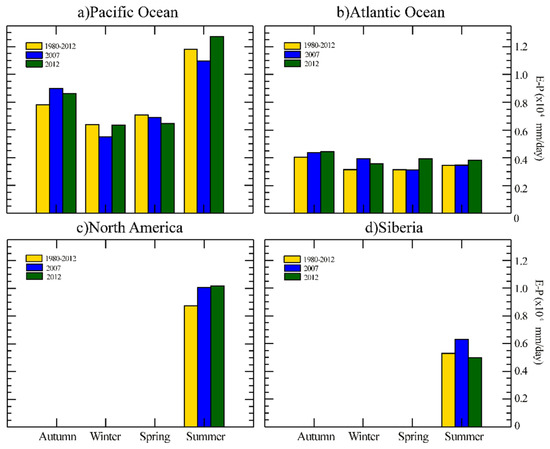
Figure 8.
Seasonal mean moisture contribution over the total Arctic domain for 1980–2012 (yellow bar), 2006/2007 (blue bar) and 2011/2012 (green bar) from (a) Pacific Ocean; (b) Atlantic Ocean; (c) North America and (d) Siberia.
The total seasonal contribution for 2011/2012 (green bar in Figure 8) shows that moisture transport from the Pacific moisture source was greater for autumn and summer, and decreased in the other seasons. The Atlantic moisture contribution increased in all seasons, as did the North American contribution in summer. Finally, the contribution of the Siberian source showed a slight decrease this year compared with the climatology.
3.3. Contrasting Analysis: Maximum September Sea Ice Extent
To analyse the influence of moisture transport on sea ice extent it is interesting to investigate not only the situation for minimum sea ice extent but also for those years showing maximum coverage during September. The maximum September sea ice extent occurred during September 1996 (see Figure 9). With the purpose of analysing variations in moisture supply associated with maximum and minimum sea ice extent in September, and taking in mind that the behaviour of the previous summer is important in the moisture supply to the Arctic system related with the minimum, the summer contribution was analysed for 1996, and then it was compared with the 2007 situation. Figure 10 shows the anomalous moisture contribution for the year 1996 from the four climatological sources.
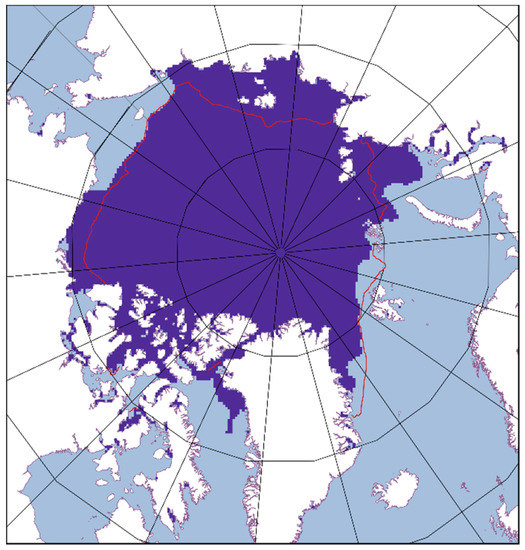
Figure 9.
September minimum sea ice extent for 1996 and the climatological 1981–2010 mean (red contour). Data obtained from National Snow and Ice Data Center (NSIDC).
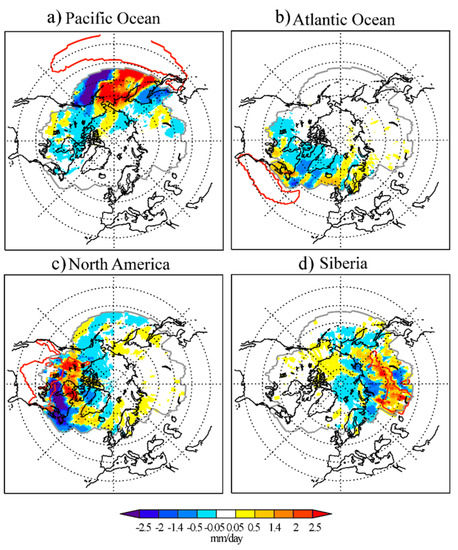
Figure 10.
Summer (E–P) < 0 anomalies for 1996 in the forward experiment from (a) the Pacific Ocean (b) the Atlantic Ocean (c) North America and (d) Siberia. Reddish colours represent areas over which the moisture supply is greater that year from the selected source (positive anomalies) and bluish colours represent areas where the moisture uptake is lower that year (negative anomalies). Contour red lines represent climatological moisture sources for the Arctic system.
If the sea ice extent during 2007 (Figure 1) is observed, it can be seen that major differences occurred over the Laptev and East Siberian seas, the Barents and Kara Sea and the Canadian Arctic Archipelago. Analysing moisture contribution over those areas, it is observed that the opposite situation with respect to moisture contribution occurred over those areas in 1996 (Figure 11) and 2007 (Figure 6). In the case of Laptev and East Siberian Seas, a decreased moisture contribution is observed in 1996 from the Pacific Ocean and Siberia, however an increased contribution occurred over those areas in 2007 from the same sources. With reference to the Barents and Kara Sea, an increased contribution is observed over this area from the Atlantic Ocean and Siberia in 2007. However, any anomalous contribution appears to be from the Atlantic source in 1996 and decreased supply can be observed from the Siberian source. Finally, over the Canadian Archipelago, major differences can be found with respect to the North American source. The North American contribution increased in 2007 over this area and decreased in 1996.
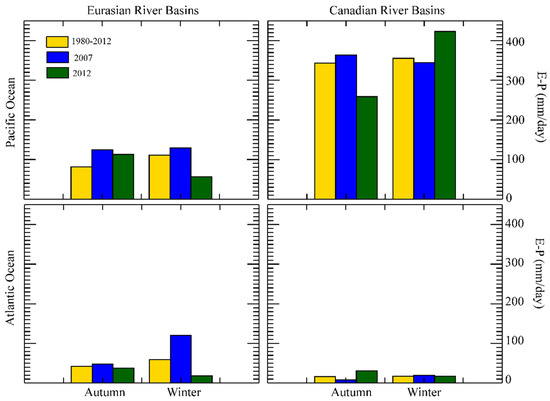
Figure 11.
Mean moisture contribution over Eurasian (left-hand column) and Canadian (right-hand column) river basins from Pacific Ocean (first row) and Atlantic Ocean (second row) for 1980–2012 (yellow bar), 2007 (blue bar) and 2012 (green bar).
3.4. River Basins
With the aim of investigating how moisture variations over the major Arctic river basins affect the extent of the sea ice, we analysed the moisture contribution over the Lena, Ob, Yenisey and Kolyma (Eurasian rivers that flow to the Arctic system, red coloured in Figure 2) together, and over McKenzie and Yukon river basins (Canadian rivers, marked in pink in Figure 2). Figure 11 shows the seasonal moisture contribution from each moisture source over the main Eurasian (left-hand column) and Canadian Arctic river basins (right-hand column). These contributions were calculated for the complete climatology (yellow bar) and for the individual periods 2006/2007 and 2011/2012 (blue and green bars, respectively) in order to assess the possible variations. As the snowpack most related with summer Arctic river discharge occurred during the period October–March [32], in this work only the autumn and winter seasons were analysed (continental sources of moisture were not analysed). In this section we assume that amplified moisture transport into the river basins leads to larger river discharge into the Arctic Ocean, however changes in river discharge were not analysed in this paper.
For 2006/2007 (blue bar), the Pacific moisture sources supplied a greater amount of moisture to the Eurasian river basin in both seasons, with the increase in moisture supply being greater in autumn compared with the climatology mean. Over the Canadian river basins, the moisture contribution only increased during autumn, showing some decrease in the winter compared with the 1980–2012 mean contribution. In general terms, the moisture contribution from the Pacific source is greater over the Canadian basins than over the Eurasian ones. In the case of the Atlantic Ocean, during 2006/2007 its contribution over the Eurasian basins increased for both seasons, as occurred for the Pacific source over these basins. Of special note is the case in winter, when the moisture contribution is more than twice the climatological mean contribution. For the Canadian basins for the same year, its contribution was also increased in winter and decreased in autumn; however, variations are small compared with the Eurasian basins.
In 2011/2012 (green bar), the Pacific moisture contribution over the Eurasian River basins showed an increase in autumn and a decrease in winter. The situation for this source is the opposite over Canadian basins. Variations are more important over these watersheds than over the Eurasian ones, showing variations of around 100 mm/day in both seasons. Moisture supply from the Atlantic Ocean decreased over the Eurasian basins during autumn and winter, with the contribution for the latter being less than half the climatological mean contribution. Over the Canadian basins, this source showed an increase in autumn, the supply in winter being almost the same as the 1980–2012 climatology mean.
4. Discussion
Moisture transport shows some important variations for those years experiencing minimum sea ice extents compared with the 1980–2012 climatology; however, the situation differs between the two years considered here.
In 2006/2007, the Pacific Ocean seems to have gained importance as a moisture source in autumn, winter, and spring; however, in summer the moisture uptake (E–P) > 0 was less than the 1980–2012 mean value (Figure 5). Its contribution to precipitation (Figure 6a) increased over some areas of major sea ice retreat north of the Bering Strait, especially in autumn but also in spring and summer over the East Siberian Sea. Kapch et al. [48] suggested a relationship between increased humidity over an area and an intensification of the sea ice retreat there. Moisture uptake (Figure 3) increased over continental areas in North America and Asia, and the Siberian moisture contribution was greater than average to the north of the climatological source. Especially remarkable is the intensification of the Atlantic Ocean as a moisture source in winter (Figure 5), showing an increase in moisture uptake greater than 4000 mm/day over the complete source. Except for during autumn 2006, this source showed positive anomalies over most of its areas for all seasons (Figure 3). This amplification of the moisture source resulted in an increased moisture contribution in every season (Figure 8), which was geographically localised over oceanic areas around Greenland and Eurasia and affecting some areas of major ice retreat such as the Barents and Kara Seas (Figure 6b). The increase in moisture supply over Eurasia produced an increase in moisture contribution over the main Arctic river basins (Figure 11) of more than 100% on an annual basis (result not shown). This increased supply can be related with the intensification in the Atlantic moisture source found for this year in winter (Figure 3). Gimeno et al. [49] have previously demonstrated the relation between intensification of this moisture source and increased moisture contribution over the Eurasian river basins. This finding is especially relevant because the Atlantic Ocean was previously found to be one of the most important sources for the Eurasian river basins [50]. In agreement with our result, Zhang et al. [32] observed an increased moisture transport into the Eurasian river basins, and Shiklomanov and Lammers [50] described a peak river discharge in 2007. Some authors have suggested a link between increased Eurasian river discharge and sea ice decline [25,26]. This relationship is in accordance with our own results, given the important sea ice retreat that occurred to the north of the main Eurasian Arctic river estuaries in 2006/2007 (Figure 1).
In 2011/2012, the continental areas showed an important intensification of the moisture uptake (Figure 3). The North American moisture contribution increased considerably for this period too, however the Siberian moisture contribution remains similar to the climatological mean (Figure 8). The Atlantic source experienced a remarkable decrease in moisture uptake over the climatological evaporative area, especially in winter (Figure 3). However, positive anomalies were found over the surrounding areas, resulting in an intensification of the ocean as a source (Figure 5). The total moisture contribution over the Arctic from this source showed increased values with respect to 1980–2012 (Figure 8). Positive anomalies in moisture uptake to the north of the climatological source (Figure 3) suggest an intensification of the moisture uptake from particles on their way to the Arctic domain, which could produce an intensification of the final moisture contribution. For the Pacific moisture source, an increased moisture contribution appears over the system in autumn and summer, producing an increased moisture supply over the Barents and Kara Seas, and over the East Siberian and Chucki Seas, respectively. In this year, important reductions occurred to the north of Russia (Figure 1). Some authors have related the sea ice reduction over this area to the occurrence of a great cyclone originating in Siberia in August of that year [51,52,53].
Despite seasonal variations in moisture contribution; it seems like summer conditions are crucial for the variability of sea ice extent for both years, as it is in this season when major retreats were observed. In the case of 2007 increased moisture contribution was observed, in general, over the Laptev and East Siberian Seas, Barents and Kara Seas and the Canadian Arctic archipelago (those areas of major retreat). In the case of 2012 such a clear relation cannot be addressed. For this year positive anomalies in moisture contribution appeared north of the Bering Strait, where ice retreat was especially high. However, most of the sources decreased moisture contribution over the Barents and Kara seas for this year, where the retreat was even higher than for 2007.
Finally, if we compare the sea ice extent over the Barents and Kara seas (Figure 1) an important difference can be observed between the two years. This difference seems to be related to the path of the moisture transport associated with the Atlantic moisture source. In Figure 6b we note that moisture transport from the Atlantic moisture source showed an eastward movement into Eurasia in 2006/2007, meanwhile, in 2011/2012 (Figure 7b) the moisture contribution showed a major northeastward trend. An important amount of moisture from the Atlantic Ocean is transported into the Arctic by cyclones [54], especially in winter [55]. Storms play an important role in sea ice reduction [19] and have been proven to affect the sea ice extent over this area [56].
5. Conclusions
We have analysed the variation in moisture transport occurring in the years 2006/2007 and 2011/2012 and have attempted to relate this to the minimum Arctic sea ice extent observed in these years.
Important variations in moisture transport over the Arctic have become apparent for those years with minimum sea ice extents. For the year 2006/2007, for example, an increase in moisture contribution over the Arctic domain was observed from continental sources in summer and from the Atlantic source in autumn and winter. In the case of the 2011/2012 minimum extent, increases in moisture supply were observed from every source with the exception of Siberia in summer, and the Pacific Ocean in winter and spring. From our results, it seems increased summer moisture contribution may be related with sea ice retreat. In general, positive anomalies were found over areas of major retreat for this season.
From our results, increased moisture transport over the main Arctic river basins seems to have some implications for the sea ice reductions observed over the Arctic Ocean. Moisture transport over these basins was not the same for both years. In 2006/2007 the Atlantic moisture contribution increased by more than 100% over the Eurasian river basins. In the same year, anomalous sea ice reductions occurred over the Arctic Ocean to the north of the basins. Despite the observed moisture increase and the importance of Atlantic Ocean as a source for this watershed, further analysis should be undertaken in order to assess the strength of the relationship between river discharge and sea ice extent.
The Atlantic moisture source seems to be especially related to the sea ice extent over the Barents and Kara Sea regions. Over these areas, greater sea ice reductions were observed in 2011/2012, when the moisture transport from the Atlantic source had a northward component, bringing moisture into the area of major retreat.
Acknowledgments
The authors acknowledge funding by the Spanish government within the EVOCAR (CGL2015-65141-R) project, which is also funded by FEDER (European Regional Development Fund). Raquel Nieto was also supported by the Brazilian government through a CNPq grant 314734/2014-7.
Author Contributions
Raquel Nieto and Luis Gimeno designed, proposed and conducted the research; Marta Vazquez performed the experiments and analysed the data; Marta Vazquez, Raquel Nieto, Luis Gimeno, and Anita Drumond wrote the paper.
Conflicts of Interest
The authors declare no conflict of interest. The founding sponsors had no role in the design of the study; in the collection, analyses, or interpretation of data; in the writing of the manuscript, or in the decision to publish the results.
References
- Stroeve, J.C.; Kattsov, V.; Barrett, A.; Serreze, M.; Pavlova, T.; Holland, M.; Meier, W.N. Trends in Arctic sea ice extent from CMIP5, CMIP3, and observations. Geophys. Res. Lett. 2012, 39, L16502. [Google Scholar] [CrossRef]
- Stroeve, J.; Holland, M.M.; Meier, W.; Scambos, T.; Serreze, M. Arctic sea ice decline: Faster than forecast. Geophys. Res. Lett. 2007, 34, L09501. [Google Scholar] [CrossRef]
- Comiso, J.C.; Parkinson, C.L.; Gersten, R.; Stock, L. Accelerated decline in the Arctic sea-ice cover. Geophys. Res. Lett. 2008, 35, L01703. [Google Scholar] [CrossRef]
- Parkinson, C.L.; DiGirolamo, N.E. New visualizations highlight new information on the contrasting Arctic and Antarctic sea-ice trends since the late 1970s. Remote Sens. Environ. 2016, 183, 198–204. [Google Scholar] [CrossRef]
- Holland, M.M.; Bitz, C.M.; Tremblay, B. Future abrupt reductions in the summer Arctic sea ice. Geophys. Res. Lett. 2006, 33, L23503. [Google Scholar] [CrossRef]
- Gregory, J.M.; Stott, P.A.; Cresswell, D.J.; Rayner, N.A.; Gordon, C.; Sexton, D.M.H. Recent and future changes in Arctic sea ice simulated by the HadCM3 AOGCM. Geophys. Res. Lett. 2002, 29, 2175. [Google Scholar] [CrossRef]
- Laxon, S.W.; Giles, K.A.; Ridout, A.L.; Wingham, D.J.; Willatt, R.; Cullen, R.; Kwok, R.; Schweiger, A.; Zhang, J.; Haas, C.; et al. CryoSat-2 estimates of Arctic sea ice thickness and volume. Geophys. Res. Lett. 2013, 40, 732–737. [Google Scholar] [CrossRef]
- Cavalieri, D.J.; Parkinson, C.L. Arctic sea ice variability and trends, 1979–2010. Cryosphere 2012, 6, 881–889. [Google Scholar] [CrossRef]
- Meier, W.N.; Gerland, S.; Granskog, M.A.; Key, J.R.; Haas, C.; Hovelsrud, G.K.; Kovacs, K.; Makshtas, A.; Michel, C.; Perovich, D.; et al. Sea ice. In AMAP (2011) Snow, Water, Ice and Permafrost in the Arctic (SWIPA): Climate Change and the Cryosphere; Arctic Monitoring and Assesment Programme (AMAP): Oslo, Norway, 2011; Chapter 9. [Google Scholar]
- Serreze, M.C.; Holland, M.M.; Stroeve, J. Perspectives on the Arctic’s Shrinking Sea-Ice Cover. Science 2007, 315, 1533–1536. [Google Scholar] [CrossRef] [PubMed]
- Gloersen, P.; Campbell, W.J.; Cavalieri, D.J.; Comiso, J.C.; Parkinson, C.L.; Zwalley, H.J. Satellite passive microwave observations and analysis of Arctic and Antarctic sea ice, 1978–1987. Ann. Glaciol. 1993, 17, 149–154. [Google Scholar]
- Parkinson, C.L.; Cavalieri, D.J.; Gloersen, P.; Zwally, H.J.; Comiso, J.C. Arctic sea ice extents, areas, and trends, 1978–1996. J. Geophys. Res. 1999, 104, 20837–20856. [Google Scholar] [CrossRef]
- Parkinson, C.L. Global Sea Ice Coverage from Satellite Data: Annual Cycle and 35-Yr Trends. J. Clim. 2014, 27, 9377–9382. [Google Scholar] [CrossRef]
- Stroeve, J.; Serreze, M.C.; Holland, M.M.; Kay, J.E.; Malik, J.; Barrett, A.P. The Arctic’s rapidly shrinking sea ice cover: A research synthesis. Clim. Chang. 2012, 110, 1005. [Google Scholar] [CrossRef]
- Screen, J.A.; Simmonds, I. The central role of diminishing sea ice in recent Arctic temperature amplification. Nature 2010, 464, 1334–1337. [Google Scholar] [CrossRef] [PubMed]
- Kopec, B.G.; Feng, X.; Michel, F.A.; Posmentier, E.S. Influence of sea ice on Arctic precipitation. Proc. Natl. Aacd. Sci. USA 2016, 113, 46–51. [Google Scholar] [CrossRef] [PubMed]
- Tang, Q.; Zhang, X.; Yang, X.; Francis, J.A. Cold winter extremes in northern continents linked to Arctic sea ice loss. Environ. Res. Lett. 2013, 8, 014036. [Google Scholar] [CrossRef]
- Screen, J.A. Influence of Arctic sea ice on European summer precipitation. Environ. Res. Lett. 2013, 8, 044015. [Google Scholar] [CrossRef]
- Vihma, T. Effects of Arctic Sea Ice Decline on Weather and Climate: A Review. Surv. Geophys. 2014, 35, 1175–1214. [Google Scholar] [CrossRef]
- Fetterer, F.; Knowles, K.; Meier, W.; Savoie, M. Sea Ice Index; National Snow and Ice Data Center: Boulder, CO, USA, 2002. [Google Scholar]
- Polyakov, I.V.; Walsh, J.E.; Kwok, R. Recent changes in the Arctic multiyear sea ice coverage and its likely causes. Bull. Am. Meteorol. Soc. 2012, 96, 145–151. [Google Scholar] [CrossRef]
- Nghiem, S.V.; Rigor, I.G.; Perovich, D.K.; Clemente-Colón, P.; Weatherly, J.W.; Neumann, G. Rapid reduction of Arctic perennial sea ice. Geophys. Res. Lett. 2007, 34, L19504. [Google Scholar] [CrossRef]
- Maslanik, J.; Fowler, C.; Stroeve, J.; Drobot, S.; Zwally, J.; Yi, D.; Emery, W. A younger, thinner Arctic ice cover: Increased potential for rapid, extensive sea-ice loss. Geophys. Res. Lett. 2007, 34, L24501. [Google Scholar] [CrossRef]
- Nummelin, A.; Ilicak, M.; Li, C.; Smedsrud, L.H. Consequences of future increased Arctic runoff on Arctic Ocean stratification, circulation, and sea ice cover. J. Geophys. Res. Oceans 2016, 121, 617–637. [Google Scholar] [CrossRef]
- Bauch, D.; Hölemann, J.A.; Nikulina, A.; Wegner, C.; Janout, M.A.; Timokhov, L.A.; Kassens, H. Correlation of river water and local sea-ice melting on the Laptev Sea shelf (Siberian Arctic). J. Geophys. Res. Oceans 2013, 118, 550–561. [Google Scholar] [CrossRef]
- Nghiem, S.V.; Hall, D.K.; Rigor, I.G.; Li, P.; Neumann, G. Effects of Mackenzie River discharge and bathymetry on sea ice in the Beaufort Sea. Geophys. Res. Lett. 2014, 41, 873–879. [Google Scholar] [CrossRef]
- Simmonds, I.; Keay, K. Extraordinary September Arctic sea ice reductions and their relationships with storm behavior over 1979–2008. Geophys. Res. Lett. 2009, 36, L19715. [Google Scholar] [CrossRef]
- Mesquita, M.; Hodges, K.I.; Atkinson, D.E.; Bader, J. Sea-ice anomalies in the Sea of Okhotsk and the relationship with storm tracks in the Northern Hemisphere during winter. Tellus A 2011, 63, 313–323. [Google Scholar] [CrossRef] [Green Version]
- Francis, J.A.; Hunter, E. New insight into the disappearing Arctic Sea ice. Eos Trans. Am. Geophys. Union AGU 2006, 87, 509–511. [Google Scholar] [CrossRef]
- Francis, J.A.; Hunter, E. Changes in the fabric of the Arctic’s greenhouse blanket. Environ. Res. Lett. 2007, 2, 045011. [Google Scholar] [CrossRef]
- Mortin, J.; Svensson, G.; Graversen, R.G.; Kapsch, M.L.; Stroeve, J.C.; Boisvert, L.N. Melt onset over Arctic sea ice controlled by atmospheric moisture transport. Geophys. Res. Lett. 2016, 43, 6636–6642. [Google Scholar] [CrossRef]
- Zhang, X.; He, J.; Zhang, J.; Polyakov, I.; Gerdes, R.; Inoue, J.; Wu, P. Enhanced poleward moisture transport and amplified northern high-latitude wetting trend. Nat. Clim. Chang. 2012, 3, 47–51. [Google Scholar] [CrossRef]
- Peterson, B.J.; Holmes, R.M.; McClelland, J.W.; Vörösmarty, C.J.; Lammers, R.B.; Shiklomanov, A.I.; Shiklomanov, I.A.; Rahmstorf, S. Increasing river discharge to the Arctic Ocean. Science 2002, 98, 2171–2173. [Google Scholar] [CrossRef] [PubMed]
- McClelland, J.W.; Déry, S.J.; Peterson, B.J.; Holmes, R.M.; Wood, E.F. A pan-arctic evaluation of changes in river discharge during the latter half of the 20th century. Geophys. Res. Lett. 2006, 33, L06715. [Google Scholar] [CrossRef]
- Whitefield, J.; Winsor, P.; McClelland, J.; Menemenlis, D. A new river discharge and river temperature climatology data set for the pan-Arctic region. Ocean Model. 2015, 88, 1–15. [Google Scholar] [CrossRef]
- Gimeno, L.; Dominguez, F.; Nieto, R.; Trigo, R.M.; Drumond, A.; Reason, C.; Taschetto, A.S.; Ramos, A.M.; Kumar, R.; Marengo, J. Major Mechanisms of Atmospheric Moisture Transport and Their Role in Extreme Precipitation Events. Annu. Rev. Environ. Resour. 2016, 41, 117–141. [Google Scholar] [CrossRef]
- Stohl, A.; James, P.A. A Lagrangian Analysis of the Atmospheric Branch of the Global Water Cycle. Part I: Method Description, Validation, and Demonstration for the August 2002 Flooding in Central Europe. J. Hydrometeorol. 2004, 5, 656–678. [Google Scholar] [CrossRef]
- Stohl, A.; James, P.A. A Lagrangian Analysis of the Atmospheric Branch of the Global Water Cycle. Part II: Moisture Transports between Earth’s Ocean Basins and River Catchments. J. Hydrometeorol. 2005, 6, 961–984. [Google Scholar] [CrossRef]
- Dirmeyer, P.A.; Brubaker, K.L. Characterization of the Global Hydrologic Cycle from a Back-Trajectory Analysis of Atmospheric Water Vapor. J. Hydrometeorol. 2007, 8, 20–37. [Google Scholar] [CrossRef]
- Gimeno, L.; Nieto, R.; Drumond, A.; Castillo, R.; Trigo, R.M. Influence of the intensification of the major oceanic moisture sources on continental precipitation. Geophys. Res. Lett. 2013, 40, 1443–1450. [Google Scholar] [CrossRef]
- Gimeno, L.; Stohl, A.; Trigo, R.M.; Domínguez, F.; Yoshimura, K.; Yu, L.; Drumond, A.; Durán-Quesada, A.M.; Nieto, R. Oceanic and Terrestrial Sources of Continental Precipitation. Rev. Geophys. 2012, 50, RG4003. [Google Scholar] [CrossRef]
- Roberts, A.; Cassano, J.; Döscher, R.; Hinzman, L.; Holland, M.; Mitsudera, H.; Sumi, A.; Walsh, J.E.; Alessa, L.; Alexeev, V.; et al. A Science Plan for Regional Arctic System Modeling: A Report to the National Science Foundation from the International Arctic Science Community; International Arctic Research Center (IARC): University of Alaska, Fairbanks, AK, USA, 2010. [Google Scholar]
- Dee, D.P.; Uppala, S.M.; Simmons, A.J.; Berrisford, P.; Poli, P.; Kobayashi, S.; Andrae, U.; Balmaseda, M.A.; Balsamo, G.; Bauer, P.; et al. The ERA-Interim reanalysis: Configuration and performance of the data assimilation system. Q. J. R. Meteorol. Soc. 2011, 137, 553–597. [Google Scholar] [CrossRef]
- Gimeno, L.; Nieto, R.; Trigo, R.M.; Vicente, S.; Lopez-Moreno, J.I. Where does the Iberian Peninsula moisture come from? An answer based on a Largrangian approach. J. Hydrometeorol. 2010, 11, 421–436. [Google Scholar] [CrossRef]
- Gimeno, L.; Drumond, A.; Nieto, R.; Trigo, R.M.; Stohl, A. On the origin of continental precipitation. Geophys. Res. Lett. 2010, 37. [Google Scholar] [CrossRef]
- Numagati, A. Origin and recycling processes of precipitation water over the Eurasian continent: Experiments using an atmospheric general circulation model. J. Geophys. Res. 1999, 104, 1957–1972. [Google Scholar] [CrossRef]
- Vazquez, M.; Nieto, R.; Drumond, A.; Gimeno, L. Moisture transport into the Arctic: Source-receptor relationships and the roles of atmospheric circulation and evaporation. J. Geophys. Res. Atmos. 2016, 121. [Google Scholar] [CrossRef]
- Kapsch, M.L.; Graversen, R.G.; Tjernström, M. Springtime atmospheric energy transport and the control of Arctic summer sea-ice extent. Nat. Clim. Chang. 2013, 3, 744–748. [Google Scholar] [CrossRef]
- Gimeno, L.; Vázquez, M.; Nieto, R.; Trigo, R.M. Atmospheric moisture transport: The bridge between ocean evaporation and Arctic ice melting. Earth Syst. Dyn. 2015, 6, 583–589. [Google Scholar] [CrossRef]
- Shiklomanov, A.I.; Lammers, R.B. Record Russian river discharge in 2007 and the limits of analysis. Environ. Res. Lett. 2009, 4, 045015. [Google Scholar] [CrossRef]
- Parkinson, C.L.; Comiso, J.C. On the 2012 record low Arctic sea ice cover: Combined impact of preconditioning and an August storm. Geophys. Res. Lett. 2013, 40, 1356–1361. [Google Scholar] [CrossRef]
- Zhang, J.; Lindsay, R.; Schweiger, A.; Steele, M. The impact of an intense summer cyclone on 2012 Arctic sea ice retreat. Geophys. Res. Lett. 2013, 40, 720–726. [Google Scholar] [CrossRef]
- Simmonds, I.; Rudeva, I. The great Arctic cyclone of August 2012. Geophys. Res. Lett. 2012, 39, L23709. [Google Scholar] [CrossRef]
- Sorteberg, A.; Walsh, J.E. Seasonal cyclone variability at 70°N and its impact on moisture transport into the Arctic. Tellus A 2008, 60, 570–586. [Google Scholar] [CrossRef]
- Zhang, X.; Walsh, J.E.; Zhang, J.; Bhatt, U.S.; Ikeda, M. Climatology and interannual variability of Arctic cyclone activity: 1948–2002. J. Clim. 2004, 17, 2300–2317. [Google Scholar] [CrossRef]
- Boisvert, L.N.; Petty, A.A.; Stroeve, J.C. The Impact of the Extreme Winter 2015/16 Arctic Cyclone on the Barents–Kara Seas. Mon. Weather Rev. 2016, 144, 4279–4287. [Google Scholar] [CrossRef]
© 2017 by the authors. Licensee MDPI, Basel, Switzerland. This article is an open access article distributed under the terms and conditions of the Creative Commons Attribution (CC BY) license ( http://creativecommons.org/licenses/by/4.0/).